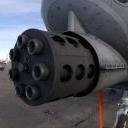-
Posts
1,279 -
Joined
-
Last visited
-
Days Won
29
Content Type
Profiles
Forums
Gallery
Blogs
Downloads
Wiki
Everything posted by TreeA10
-
The sun hits the Earth with 173,000 trillion watts of solar power every day which is 10,000 times what humans use and somehow we are causing a change? I'd give the global cooling/warming/climate change crowd more credibility if just one of their predictions had come true over the past 40 years. You would think with perfect hindsight at least one climate model would be accurate.
-
I'm now searching for concealed carry holsters for a compact and subcompact pistol. So, how do you carry (IWB, appendix, small of back) and what holster do you like?
-
Not sure if the report is still out there but a Confidential report discussing the defense of Taiwan with every F-22 we own got released online. The report used Chinese basing options and aircraft availability vs US basing options which was minimal with tankers required. When the balloon goes up and the fight starts, the report assumed 100% Pk (hardly likely) of US missiles and, guess what, you run out of missiles with hordes still inbound. Admittedly, the US Navy was not included nor other fighter types but the report does a good job with the argument of quality vs quantity and confirms the old Soviet argument of "quantity has a quality of it's own."
-
Yes, we are carrying cargo but I've not paying attention except for my last flight which was back from Paris. We had 24Klbs and someone said we needed 28Klbs to break even but I can't verify that. I'm flying a cargo only flight later this month to London and next month to Incheon so we'll see how those look.
-
Last 6 flights I flew between DFW-Narita or DFW-Paris, max passenger load was 43, min load was 20.
-
Arch nemesis of Carlos Danger?
-
The journalistic track record using the last 3 years isn't a good one. How many stories based on "anonymous" sources turned out to be a total fabrication? News networks and journalists banged the RUSSIA, RUSSIA, RUSSIA drum for how many years interviewing how many sources (Schiff, Clapper, Brennan come to mind) and were told "We have proof" and, yet, no interest in finding out why they were lied to, and more importantly, why they lied to the American people over and over again. Oddly enough, they didn't lie to Congress but not a wisp of interest as to why. Journalists have not done themselves any favors over the last couple years so it's hard to put much stock in their reportage.
-
Thanks for a walk down bad memory lane. I had 3 Kuwaiti students. Every day was a WTF experience. Lost one in the invasion. Those guys came here with enormous cultural and language barriers and proved anything can be done if you throw enough money at the problem.
-
They must have forgot that Coast Guard tankers are painted white and orange. It's a common error.
-
I guess this is another way of getting folks through the program. During my days as a T-38 IP and everyone flew the T-38 (Get off my lawn!!!), we had a kid that required 7 extra rides to get through his T-38 Contact Check. (Funniest write-up: XXX landed on speed and scared himself.) This guy ended up with @20 extra rides in the program and got through. Someone really, really wanted for him to get through the program.
-
What happens when this person gets to a squadron and finds that the majority of the squadron is genetically different? Going to ask for help or going to wait for the squadron demographics to change? You have to fight with what you have where you find the fight not what you wish you had and where you wish you were. I admit getting through the program is a foot in the door, which is great, but the education in UPT is more than just stick and rudder activation.
-
We went with the G43 ($379) for her. Where did you buy the 8 round magazine? I've have found a couple sources online and wondering about the quality of the product. Can't say I've bought any guns for a while when we went to Weatherford, TX to a place called Gibsons Hardware. Admittedly it was a Saturday afternoon and that place was amazingly busy with quite the crowd milling around the firearms section. In 30-40 minutes I was there, I watched them sell 6 or so handguns. No 9mm for sale unless you purchased a gun. The wife took the .40 Sig out and shot with a friend of ours that will be teaching the carry class. He took us out to his range to shoot. She easily qual'd shooting but still isn't comfortable handling the gun and is smart enough to admit it and ask questions. I ordered some snap caps to allow her to practice loading and misfire clearing.
-
I've been the asker of that question but in regard to shoes. Okay, found a Blue Label Glock dealer and leaning towards the 43 for the wife. 26 is similar but a double stack so it's also possible. Maybe a 19 for me. Any idea if any of these guns are convertible to .22 for economical practice? At current prices, .50 cents per trigger pull can get expensive quick and I'm encouraging the spouse to get a lot of range time initially. Gun safes and home storage? I've got nothing now and have 6 or so long guns and a couple shotguns and a little ammo. So, basically woefully unprepared for the zombie apocalypse or a Saturday night stay in Portland. What do you guys recommend for safe keeping and storage?
-
https://www.snopes.com/fact-check/florida-motorcyclist-covid-death/. This guys death was initially recorded as Covid but then changed. Why was it recorded as COVID in the first place? https://www.mysuncoast.com/2020/07/19/concerns-arise-some-receive-positive-covid-results-never-got-tested/ https://www.wpxi.com/news/top-stories/people-never-tested-covid-19-report-calls-saying-theyre-infected/CRJSXJC6EFD5TAC6AFWZFFQYP4/
-
I'm not a big conspiracy guy and don't own a tinfoil hat but the reporting of cases and deaths has become suspect. A guy in Florida had COVID and was involved in a fatal crash on his motorcycle. Cause of death is listed as COVID. Similar incidents have occurred in other states. People have signed up to get tested for COVID and leave without being tested and are contacted later saying they tested positive. What is driving the need to get numbers of deaths and positives tests up? In the grand accounting scheme, the actual numbers falsely attributed to COVID is probably small in comparison to real numbers but why inflate the numbers?
-
Okay, leaning towards the 9mm. She has borrowed a .40SW to shoot tomorrow and finding ammo for that gun was easier than I thought although I lucked out and went to the only place in the town that had it. Limit 50rnds, 1 per person. Looking at purchases, a Glock 19MOS is $595 on AAFES. I called a local dealer that does Blue Label and the same gun was $492. Anyone with experience with the MOS sight and pros/cons, functionality with concealed carry?
-
Because....you know....the thing!!
-
Great info. Thanks for the input! Guy in the neighborhood is retired LEO and will now be my go to guy if the zombie apocalypse hits. Easily 350 guns plus and a closet of ammo. Nice selection of handguns and he teaches a variety of gun training classes. MP shield and Glock 19 were favorites. I don't think she will carry although her school is asking teachers to do so if trained and willing. So, looks like nightstand for her but I might carry. She has a carry class with range time scheduled for next week and it's borrowing something in a .40SW for the class. I need to come up with a box of ammo. More questions: Best place for ammo? Any experience with Blue Label or AAFES Glock purchase? Best carry technique for sandals, shorts and golf shirts?
-
The wife is inquiring about a handgun. I started reading this thread... Again... From the beginning then gave up. Many links are now no longer valid. So.. Suggestions for a pistol for the spouse? I have rifles, no handguns, and was also thinking of getting something for concealed carry for myself. I'd like to simplify logistics with coming magazines or maybe just caliber If feasible.
-
You are not wrong. He does need to someone to dart him and take his phone away. Let him compose Tweets that are reviewed by at least 2 other people before hitting send. As far as speeches go, keep him somewhat close to whatever is on the teleprompter.
-
Trump also does a great job of trolling the media, liberals, and leftists...but I repeat myself. Trump throws out comments he knows are going to set those people off and they fall for it every. Single. Time. They will spin themselves into a frenzy much like a cat after the little red dot of a laser pointer. Can't say I approve of the technique but it can be entertaining to watch.
-
Some reports include fireworks being stored with the ammonia nitrate. Brilliant!
-
Statement read to AF promotion boards in the mid 90's: "Special consideration should be given to women and minorities for possible past discrimination."
-
In my last couple of passes through the AA schoolhouse for 787 and 777 recurrent training, we have done full stalls clean at altitude, @FL400, and stalls configured inside the FAF. The stall series requires pulling the throttles to idle and holding attitude allowing the speed to bleed off while ignoring the warnings and using enormous back pressure on the yoke to hold attitude to allow the stall and sink rate (i.e. Air France 774) to fully develop. Unload while applying full throttle to recover works nicely but altitude loss, no surprise, will occur in both cases. We've also done severe upset recoveries on departure or vectors to approach. The stalls you knew were coming, the upset not so much but in both cases you knew something was going to happen. How you simulate a complete unknown and generate a startle effect with the subsequent confusion, I'm not sure, but shoving the nose of a big jet 30 degrees nose low ANYTIME is just not right and how to prevent that through training might be a question to ask.
-
You might want to do some guesstimating on the future as current conflicts will end (I hope) and the contribution of the Worlds Best CAS platform will no longer be required and the Big Blue long desired demise of the Hawg will come to pass. The only constant is change but parking the A-10 within 6-9 years, or sooner, should not be a surprise.





